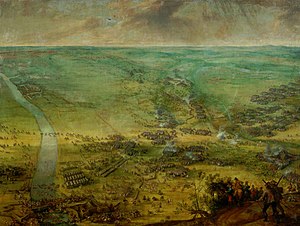| Battle of Thionville | |||||||
|---|---|---|---|---|---|---|---|
| Part of the Thirty Years' War and the Franco-Spanish War (1635–59) | |||||||
 The Battle at Deidenhofen (Thionville) 1639, by Peter Snayers | |||||||
| |||||||
| Belligerents | |||||||
|
|
| ||||||
| Commanders and leaders | |||||||
|
|
| ||||||
| Strength | |||||||
|
9,000 infantry 2,600 cavalry |
9,000 infantry 5,000 cavalry | ||||||
| Casualties and losses | |||||||
|
6,000 dead or wounded 3,000 captured | 1,500 dead or wounded | ||||||
| Thirty Years' War | |||||||||||||||
|---|---|---|---|---|---|---|---|---|---|---|---|---|---|---|---|
| |||||||||||||||
| Treaties | |||||||||||||||
The Relief of Thionville took place on 7 June 1639, during the Thirty Years' War.
Prelude
Coordinated French and Dutch attacks on the Spanish Netherlands in May 1638 forced Spain to abandon a planned offensive in Artois. Despite fighting on two fronts simultaneously, the Spanish Army of Flanders managed to defeat the Dutch at Kallo in June while Thomas Francis, Prince of Carignano and the Imperial auxiliary corps under Ottavio Piccolomini lifted the French Siege of Saint-Omer in July. France renewed his attacks in 1639 by besieging Hesdin with 14,000 men under La Meilleraye supported by additional troops under Châtillon. The Marquis de Feuquieres was ordered to capture the principal fortress of Thionville in the Duchy of Luxemburg. Control of Thionville secured access to the southern Spanish Netherlands and the Moselle Valley, it also enabled the Imperials to support their Spanish allies by threatening the French flank.
Battle
Feuquieres had laid siege to Thionville with 12,000 French troops. An Imperial-Spanish relief force commanded by Piccolomini with 5,000 cavalry and 9,000 infantrymen arrived in early morning of 7 June to lift the siege. This force included a Spanish contingent led by the Luxembourgish baron Jean de Beck, with the tercio of Naples and the artillery directed by Ernest de Suys.
In the morning, the Imperials attacked the opposing positions, then the battle stopped for a while which allowed the French to line up (11:00), while Piccolomini sent reinforcements inside the fortress. The Imperials returned to the attack (16.00) and conquered the hill on the left side to the French, where Piccolomini placed the artillery. Under Imperial artillery fire, the French cavalry was charged by the Imperial cavalry under the Marquis Camillo Gonzaga. The French cavalry was defeated and persecuted. The garrison sallied out against the French right flank.
The Imperials enveloped and defeated the French infantry, capturing all the artillery and numerous materials. The French army lost 6,000 dead and wounded as well as 3,000 prisoners including Feuquieres, who died from his injuries, and Count Pas, commander of the infantry. The victorious Imperial-Spanish army only lost 1,500 men.
Aftermath
Feuquières, wounded in the fighting, was captured by the Imperial forces and died in captivity. In recognition of his victory, Piccolomini was created Duke of Amalfi by the Spanish Crown on 28 June.
In 1643 the Duc d'Enghien capitalised on his victory at Rocroi by pushing on to Thionville, which fell after a stubborn defence by the Spanish garrison.
Notes
- Parrott (2001), p. 137
- ^ Thion 2008, p. 129.
- ^ Bodart 1908, p. 65.
- Wilson 2009, p. 661.
- Jacques (2006), p. 1013
References
- Bodart, Gaston (1908). Militär-historisches Kriegs-Lexikon (1618-1905). Retrieved 21 November 2021.
- Jacques, Tony (2006). Dictionary of Battles And Sieges: A Guide to 8,500 Battles from Antiquity Through the Twenty-first Century. Greenwood Publishing Group Publishing. ISBN 978-0-313-33536-5.
- Parrott, David (2001). Richelieu's army: war, government, and society in France, 1624-1642. Cambridge University Press.
- Thion, Stéphane (2008). French Armies of the Thirty years War. LRT Editions. ISBN 978-2-917747-01-8.
- Wilson, Peter H. (2009). Europe's Tragedy: A History of the Thirty Years War. Allen Lane. ISBN 978-0-7139-9592-3.
- https://web.infinito.it/utenti/f/francots/rin30/thionvil.htm
49°21′32″N 6°10′09″E / 49.3589°N 6.1692°E / 49.3589; 6.1692
Categories: